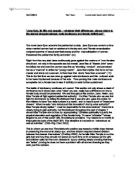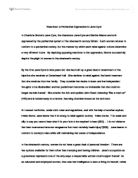Brocklehurst then goes on to belittle Jane in front of the Brocklehurst’s, teachers and children; Branding Jane an “Evil one”, “interloper” and an “alien” and warning the teachers of her behaviour and instructing the children not to talk to her as he does not want her to “contaminate” their “purity”. (78-79).
But Brocklehurst does not realise by placing Jane on top a stool he is symbolically giving her power. A compassionate observer of Jane’s public humiliation, Miss Temple persuades Jane to redeem herself and to challenge the Reverend’s allegation about her “You have been charged with falsehood; defend yourself as well as you can” (84). Miss Temple accepts Jane’s statement and assembles the whole school together and “announced that inquiry had been made into the charges ...completely cleared from every imputation”. (88)This showing again that Miss Temple and Jane Eyre had gained authority over Mr Brocklehurst as the teachers and children were quick to dismiss what there master had told them.
The next section we see a conflict of authority is between Jane and Rochester at Thornfield. From the very first meeting in the woods there is a conflict of dominance with Rochester and Jane. It is also the start of Rochester’s game playing, when he asks “whose house is this?” and “do you know Mr Rochester?” he is asking Jane to acknowledge the status of Rochester authorizing him as master. Yet it is he who is in need of help “you may help me a little yourself, if you will be so kind” (135) giving Jane a bit of power because is unable to mount his horse himself. Rochester is in need of Jane’s help a number of times throughout the novel, however Jane never once asks Rochester for help. He needs her when Bertha sets fire to his curtains in his bedroom to save his life. He needs Jane’s help when Bertha stabs and bites her brother, and ultimately at the end he needs her to be his sight.
He also tries to gain power by playing games with Jane; he does this by pretending to be a gypsy and through Blanche. By pretending to be a gypsy to Jane and Blanche he is playing with them to find out things for himself thus giving him power in the knowledge of their reaction to what he tells them. He tells Blanche that Rochester is going to lose his money, a trick that makes his mind up about marrying her. He then plays the gypsy to Jane talking about himself “I did not come to hear Mr Rochester’s fortune: I came to hear my own” (232). She realises that the gypsy is not real and Rochester reveals his true identity. He also tells Jane after he has proposed the reason why he pretended to like Blanche was to make Jane jealous “to render you as madly in love with me as I was with you; and I knew jealousy would be the best ally”( 303) playing games still to gain authority over Jane. Jane knows all this game playing is wrong yet she too plays it at the end of the novel when she knows she is independent and has power over Rochester; as Godfrey notices in her journal when Rochester demands “Who the deuce have you been with?” and she replies “if you twist in that way... of my substantiality”, he then continues to repeat “who have you been with” (505) and because Jane knows she has the power she makes Rochester wait till the next day to find out if she had been with anyone (Godfrey 2005).
Jane, right to the end of the novel gives Rochester power herself by calling him “sir” or “master”, even when they are about to be wed in the middle of the novel, and at the end when they are married she still calls him master; as Godfrey notices “she continues to employ the terminology of her former servile position: [Dusk as it was, I had recognised him; - it was my master, Edward Fairfax Rochester, and no other]” she is giving him authority by calling him by these terms yet she repeatedly speaks about been equal in life and marriage, making herself seemingly confusing. Rochester also calls Jane many names throughout the novel that suggest she is not human, which could be perceived as belittling Jane, he repeatedly calls her “fairy- like”, even when he tells Adele of his bride to be he describes the story as if she was a fairy “it was a fairy...Mademoiselle is a fairy” (308-309). But as Peters notices, she too also labels herself playfully and tragically. It is she that first names herself a fairy in the red room "The strange little figure...ferny dells in moors. (18). Here she associates this kind of representation as bad, but she still allows Rochester to gain authority by calling her such names and regarding her as a made up specie (Peters 1996)
He also calls Jane “little” and “young” a lot and this makes the reader address the age difference giving him dominance again, of age, and experience. Fairfax sees their engagement as a “doubly violated social taboo” (Godfrey 2005) because of their difference in class and age. Rochester tells Jane that he is only superior to her through age and experience. That would be his experience of the world including sexual experience as Godfrey notes that age can reverse the effect on sexual power but in this situation it does not as we have seen Rochester is eager to tell Jane of his previous sexual encounters, “this clearly places him in a masculine position of authority and dominance against her childlike innocence” (Godfrey 2005).
Jane would not stay with Rochester when she found out about Bertha she would not undermine herself and give him the power of been his mistress. Jane must only go back to Rochester ensuring that they marry as equals as she does not want to feel trapped in a marriage and Jane speaks clearly about this in chapter 12 “Women are supposed to be very calm...necessary for their sex” (129-130). Brocklehurst, Rochester and St John threaten Jane with the fetters of patriarchy which Jane is resisting in this passage. Jane extends the feeling of entrapment to fellow women, these sentences constitute to Bronte’s feminist manifest. This passage explicitly states that the Victorian wife suffers from being metaphorically “locked up” as we later see Bertha in this way. Jane eventually marries Rochester, and he gains his sight to see his baby boy, which then puts male dominance back to the Victorian standard regarding Jane.
But I think the most powerful person in this novel is Bertha. She is essentially locked up in a prison, and it may seem that it is Rochester who has the power over her by keeping her in the attic with a guard but it is she that continually breaks free from the prison, Beattie also has this view (Beattie 1996). He wants to marry but he can’t because she is his wife and until she dies she will have control over this as seen when he tried to marry Jane. She gets out the loft on more than one occasion, first outside Jane’s room when she is heard laughing, then when she sets fire to Rochester’s room, and ultimately burning down Thornfield and making Rochester lose his sight and hand. It is because of her that Jane leaves Rochester, proving all his downfall is down to Bertha. “The fire caused by Bertha, his "collection," symbolically burns away Rochester's colonial wealth and destroys his power as a male host and gazer, “(Chih-Ping Chen 2002).
Jean Rhys sequel Wide Sargasso Sea tells the story of how Antoinette eventually becomes Bertha. I n this novel it is the mean that have control.
“ In the second movement, the daughter who never knew a true father, and then twice lost a mother, loses herself and her property to a man whom she cannot hold either in love or even lust. Antoinette cannot hold a husband in one sense just as she never had a father to hold her in another sense.” (Rajeev S Patke 2005)
“Denial, in Wide Sargasso Sea, takes the form of the failure to love. Rochester is incompetent of something beyond an emotionless lust fumbling about in a trance, split from love and care. His rejection of guilt at the failure to love retreats on the ejected woman in the appearance of disgust. She becomes like a mirror, first wiped clean of her own selfhood, into which he then casts his self-hatred, which he conclusively breaks up as he might a doll, chanting to her the humiliating refrain "Marionette, Antoinette" (127), in an attempt to get rid of his own guilt. Towards the end, for her, lost in his England, "There is no looking-glass here and I don't know what I am like now" (147). The only wish Antoinette can nurse successfully in Wide Sargasso Sea is to die, and like her mother, she dies more than once: "There are always two deaths, the real one and the one people know about" (106). "Say die and I will die" she says to her husband; in response he declares to the reader that "I watched her die many times. In my way, not hers" (77). His deliberate casual adultery with a black servant in Antoinette's house distastes and dispossesses her of the only place she had learned to identify herself with as her natural habitat and patrimony (90). England, his home, and the house he builds there with her money, transports what had first seemed to her its dream-like unreality into the numbness of nightmare. The tragedy is that he appropriates and desecrates what he neither appreciates nor understands, a person emblematic "of a beautiful place-wild, untouched, above all untouched, with an alien, disturbing, secret loveliness" (73).(Rajeev S Patke 2005)
In conclusion we have seen that there is a struggle for dominance within Jane Eyre and how both female characters and male have dominance but undeniably the sentimental end to the novel puts back gender roles to the traditional Victorian gender roles. Whereas in the sequel we see only men having dominance and thus leading to the madness of Antoinette, there is no question about it that this novel ultimately ends with male dominance and female victimhood.
Bibliography
Beattie, Valerie, 1996. “The mystery at Thornfield: Representations of madness in Jane Eyre” Studies in the novel. Vol 28, Iss 4, pg 493-506.
Bronte, Charlotte, 2006. Jane Eyre, Penguin Classics .
Chen, Chih-Peng, 2002. ‘“Am i a monster?” Jane Eyre among the shadow of freaks. Studies in the novel. Vol 34, Iss 4. pg 367-385.
Godfrey, Esther, 2005. “Jane Eyre, from Governess to Girl Bride” Studies in English Literature, 1500-1900. Vol 45, Iss 4. pg 853-874.
Patke, S, Rajeev, 2005. “Method and Madness in a question of power and wide Sargasso sea”. The Journal of Carribean Literatures. Vol 4, Iss 1. Pg 185-194
Peters, G, John, 1996. “Inside and outside: Jane Eyre and marginalisation through labelling”. Studies in the novel. Vol 28, Iss 1. Pg 57-76.
Rhys, Jean, 1968. Wide Sargasso Sea. London:Penguin








